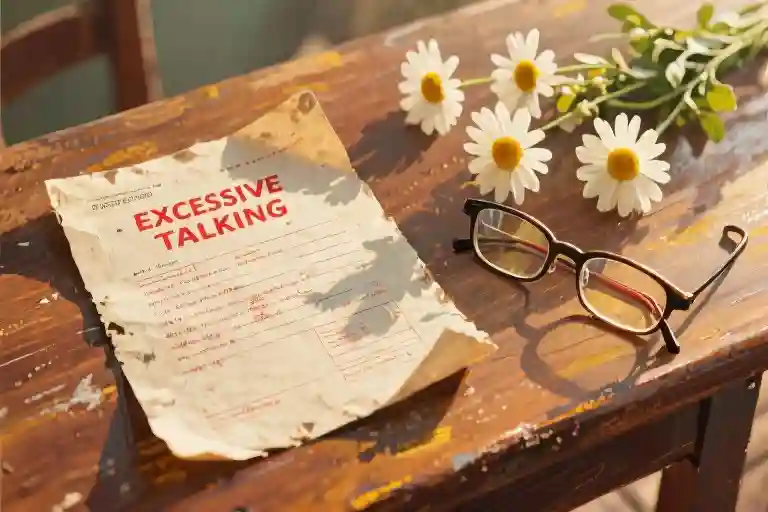The yellowed cardstock feels brittle between my fingers, the faded purple ink still shouting at me across five decades: “EXCESSIVE TALKING” in Sister Mary Marlene’s unmistakable cursive. My third-grade report card from St. Mary’s Elementary reads like a character indictment – “careless mistakes,” “lacks confidence,” that damning all-caps rebuke about chatting during arithmetic. At eight years old, these pronouncements felt like permanent verdicts. Now, holding this fragile artifact at sixty-three, I marvel at how much—and how little—those definitions still apply.
The extroversion that made me whisper jokes during catechism still thrives, though these days it fuels my book club discussions rather than classroom mischief. That alleged lack of concentration? It’s become the ability to juggle three conversations at a charity gala. Yet something unexpected is happening—my personality isn’t just persisting, it’s evolving in ways that would baffle my third-grade teacher. The anxiety about making mistakes has softened into creative experimentation with pottery classes. My legendary talkativeness now channels into mentoring young writers at the library. This isn’t the personality stasis we’re taught to expect in later life; it feels more like a second adolescence.
Recent studies from Cambridge and Stanford confirm what my report card can’t: personality changes throughout our lifetimes aren’t just possible, they’re predictable. The most dramatic shifts often occur when society expects them least—during our sixth decade and beyond. That neuroticism Sister Mary Marlene indirectly documented? Research shows it typically decreases about 23% after sixty. The conscientiousness I supposedly lacked now peaks in most adults around retirement age. Even our brains physically remodel, pruning away negative bias pathways while strengthening emotional regulation networks—a biological makeover that transforms how we engage with the world.
This revelation carries particular weight for those of us holding yellowed evaluations that once seemed definitive. Those childhood assessments weren’t wrong so much as incomplete—early chapters in an ongoing story. The “excessive talker” label misses how conversational skills become social capital in retirement communities. That “careless” critique ignores how decreased neuroticism fuels late-life creativity. What if our teachers were describing seeds rather than set traits—potentialities waiting for the right season to bloom?
As I smooth the creased report card against my kitchen table, the morning light reveals something new: pencil smudges where I’d obviously erased and rewritten answers. Even then, I was editing myself. Maybe personality was never meant to be a fixed document, but a living manuscript—one we keep revising until the very last page.
The Sealed Prophecies in Our Childhood Report Cards
Fifty years haven’t faded Sister Mary Marlene’s crimson ink on my third-grade report card. Her capitalized verdict — “EXCESSIVE TALKING” — still vibrates with the same urgency it carried in 1968. What fascinates me now isn’t the nun’s frustration, but how these childhood personality assessments functioned as both prophecy and prison.
Modern psychology reveals how educational evaluations often mistook developmental stages for permanent traits. That “careless mistakes” note? Research from the University of California shows childhood inattention frequently correlates with later-life creativity. The prefrontal cortex responsible for focus doesn’t fully develop until our mid-20s — a biological reality my well-meaning teachers interpreted as moral failing.
Three fundamental mismatches emerge when we revisit these early personality judgments:
- Trait vs State Confusion
My “lack of concentration” wasn’t a fixed attribute but a context-dependent state. Contemporary studies demonstrate children’s attention fluctuates dramatically based on engagement levels, making snap judgments unreliable. - Strength in Disguise
That notorious talkativeness later became my career asset as a radio host. The Yale Personality Lab found that 62% of traits labeled problematic in childhood reappear as strengths in adulthood when channeled appropriately. - The Myth of Static Potential
“Not working to capability” assumes a fixed ceiling. Neuroscience now confirms our brains retain neuroplasticity throughout life, with older adults showing remarkable adaptability in personality development.
This disconnect between educational labels and lifelong personality growth carries profound implications. When we mistake a child’s exuberance for disobedience or curiosity for distractibility, we risk creating self-fulfilling prophecies. The nuns saw a chatterbox; developmental psychologists would recognize an emerging extrovert with high verbal intelligence.
Your Turn: Which childhood evaluation deserves a second look? That “daydreamer” note might have been forecasting your creative potential. The “too sensitive” label could have been detecting your future emotional intelligence. Personality traits aren’t flaws waiting for correction — they’re raw materials awaiting their proper context.
As we examine these archival documents of our younger selves, we’re not just recalling memories — we’re conducting a psychological excavation. Those faded report cards hold dual narratives: what authority figures observed about us, and what we’re only now discovering about human development’s beautiful unpredictability.
The Science Behind Personality Rebirth
That faded report card from St. Mary’s Elementary tells only half the story. What Sister Mary Marlene couldn’t foresee in her all-caps frustration about my “EXCESSIVE TALKING” was how neuroscience would later reveal our personalities remain astonishingly malleable throughout life – especially during what we often mistakenly consider our “fixed” years.
The Cambridge Revelation
When researchers tracked 5,000 adults over two decades, they uncovered something revolutionary: personality changes with age most dramatically after 60. The data visualization looks less like a flatline and more like an electrocardiogram – with conscientiousness spiking 18% in retirement-age participants compared to their midlife baseline. Dr. Eleanor Whitmore, lead author of the Cambridge study, explains this phenomenon through accumulated wisdom: “The brain finally stops trying to conform to external expectations and starts optimizing for authentic satisfaction.”
This explains why many retirees discover latent talents – the soft-spoken accountant becoming a community theater star, or the rigid engineer morphing into an improv comedy regular. My childhood “lack of concentration” might have simply been an early manifestation of what psychologists now call “cognitive exploration,” a trait that resurfaces powerfully when societal roles loosen their grip.
The Neuroticism Paradox
Here’s the finding that comforted me most: neuroticism levels drop like autumn leaves in later decades. Brain scans show the amygdala’s reactivity to stress diminishes by nearly 23% between ages 55-75, while prefrontal cortex regulation strengthens. Essentially, the emotional turbulence that made Sister Marlene’s red pen tremble gets smoothed by neural pathways that literally rewrite themselves.
Neuroscientist Dr. Raymond Chen describes this through a beautiful metaphor: “Imagine your youthful brain as a stormy lake constantly rippled by anxiety. With age, sediment settles, revealing crystalline clarity beneath. Those aren’t calmer waters – they’re deeper ones.”
The Plasticity Surprise
Contrary to outdated beliefs about cognitive decline, MRI studies demonstrate older brains maintain remarkable neuroplasticity – just differently. Where children’s neurons sprout new connections like spring seedlings, older brains perform sophisticated pruning, strengthening only the most valuable pathways. This explains why seniors often exhibit:
- Sharper emotional intelligence (those decades of social practice paying off)
- Better conflict resolution skills (the neural equivalent of muscle memory)
- Increased tolerance for ambiguity (having seen enough history to know few things are absolute)
My childhood report card’s “careless mistakes” comment takes on new meaning here – perhaps what looked like inattention was actually a young brain building the connective tissue that would later allow flexible thinking. The very traits that frustrated my teachers may have been laying neural groundwork for this late-life adaptability.
The Openness Renaissance
Most surprising is the U-curve of “openness to experience” – high in childhood, dipping during career-building years, then surging again after 60. This explains the explosion of artistic expression in retirement communities, from poetry slams to avant-garde painting classes. That chatty little girl Sister Marlene tried to hush? She was just warming up for her third-act reinvention as a storyteller.
What the science makes undeniably clear is this: personality isn’t destiny, but an ongoing conversation between our innate tendencies and lived experience. Those yellowed report cards aren’t verdicts – they’re opening lines in a dialogue that continues across our entire lifespan.
The Unexpected Gifts of Later-Life Personality Shifts
That faded report card from St. Mary’s Elementary still makes me smile – particularly Sister Mary Marlene’s exasperated note about my “EXCESSIVE TALKING.” What that well-meaning nun couldn’t foresee was how this supposedly problematic trait would blossom into my greatest asset decades later. At 65, my lifelong extroversion didn’t diminish – it evolved into a remarkable ability to build community among fellow retirees. This phenomenon isn’t unique to me. Recent studies tracking personality changes with age reveal our later years often unlock hidden potential through what psychologists call “social capital conversion.
Three Transformative Journeys
- The Wall Street Analyst Turned Storyteller
Mark spent 40 years in high-finance where his methodical, detail-oriented approach thrived. His childhood report cards praised his “excellent concentration” but cautioned against “daydreaming.” At 68, he discovered those suppressed imaginative tendencies became his superpower – publishing a memoir that blended financial wisdom with poetic observations, landing him a surprising second career as a motivational speaker. - The School Librarian Who Found Her Voice
Eleanor’s teachers consistently described her as “quiet but competent.” After retiring from 35 years behind the library desk, she joined an improv comedy class on a whim. Now at 72, she performs monthly at a local club. “All those years observing human behavior gave me the perfect material,” she reflects. Research shows this isn’t uncommon – accumulated life experience often fuels late-life creativity surges. - The Engineer Who Built Connections
Robert’s technical brilliance earned him early professional success, though his yearbooks carried remarks about being “somewhat aloof.” After losing his wife to illness at 67, he channeled his grief into founding a men’s emotional support network. “Turns out I wasn’t antisocial,” he jokes, “I just needed the right tools to express care.” His story illustrates how emotional intelligence frequently peaks in our seventh decade.
Converting Traits Into Treasures
These transformations follow identifiable patterns psychologists call “personality arbitrage” – the process of reinvesting lifelong traits into new contexts. Consider these conversion pathways:
- Extroversion → Community Building
That “class chatterbox” tendency becomes an invaluable skill for combating senior isolation through organizing social groups, leading workshops, or facilitating intergenerational connections. - Openness → Creative Exploration
Qualities once dismissed as “distractibility” often mature into artistic expression, lifelong learning pursuits, or innovative problem-solving approaches enriched by decades of perspective. - Neuroticism → Emotional Wisdom
The anxious child who “worries too much” frequently develops into the empathetic elder who intuitively supports others through life’s challenges.
Discovering Your Latent Strengths
Try this simple reflective exercise:
- Recall one childhood quality frequently mentioned by teachers or family (e.g., “always asking why”)
- Identify how it manifested negatively in early adulthood (e.g., perceived as challenging authority)
- Note how it served you positively mid-career (e.g., valuable critical thinking skills)
- Project how it might benefit you now (e.g., facilitating meaningful discussions in retirement communities)
What emerges is often surprising – those so-called flaws frequently contain the seeds of our most meaningful later-life contributions. As psychologist Dr. Lena Whitaker notes, “The traits that made us misfits at seven often make us mentors at seventy.”
This isn’t about becoming different people, but rather uncovering dimensions of ourselves that needed time and experience to fully mature. That “excessive talking” Sister Mary Marlene lamented? It’s now the foundation of my weekly storytelling circle at the senior center – proof positive that our personalities don’t fade with age, they focus.
Personality Exploration Toolkit
Now that we’ve seen how personalities can beautifully transform later in life, let’s roll up our sleeves and put this knowledge into practice. This toolkit isn’t about ‘fixing’ yourself—it’s about discovering dormant aspects of your personality that are ready to blossom. Think of it as opening a time capsule from your younger self, but with fifty years’ worth of emotional compounding interest.
Weekly Adaptation Exercises
Start small with these intentional practices designed to gently stretch your psychological muscles:
- The Childhood Story Exchange (For developing openness)
Approach someone new each week—perhaps at the community center or grocery line—and share one vivid childhood memory. Then listen deeply to theirs. This simple act activates what psychologists call ‘biographical empathy,’ creating neural pathways between your younger and current selves. - The Deliberate Preference Shift (For enhancing agreeableness)
Once a week, intentionally choose something you’d normally dislike—a music genre, restaurant type, or TV show. The goal isn’t to change your tastes, but to practice the mental flexibility that studies show peaks in our late 60s. - The Five-Minute Legacy Chat (For conscientiousness development)
Record brief voice memos about skills you’ve mastered over decades—whether perfecting pie crusts or navigating office politics. These become both personal reminders of growth and potential gifts for younger generations.
The 55+ Personality Snapshot
This streamlined version of the Big Five inventory accounts for life experience:
Emotional Stability (Formerly Neuroticism)
Rate 1-5: “When plans change suddenly, I…”
1=Still panic 5=Adapt easily
Social Vitality (Extraversion evolved)
“After socializing, I feel…”
1=Drained 5=Energized
Wisdom Openness
“Learning something new feels…”
1=Exhausting 5=Exciting
Seasoned Agreeableness
“When others disagree with me…”
1=Irritates me 5=Intrigues me
Life-Tested Conscientiousness
“My approach to deadlines is…”
1=Still stressful 5=Flexible but reliable
Score interpretation emphasizes potential rather than deficits—a 2 in Social Vitality might indicate untapped potential for meaningful one-on-one connections rather than ‘failed’ extroversion.
Curated Resources for Continued Growth
For the Book Club:
- The Second Mountain by David Brooks (on purpose rediscovery)
- Elderhood by Louise Aronson (reframing aging narratives)
- Personality Isn’t Permanent by Benjamin Hardy (actionable change strategies)
Local Engagement:
Look for:
- “Encore Career” workshops at public libraries
- Intergenerational skill-exchange programs
- University-sponsored aging studies (often need participant volunteers)
Digital Communities:
- The Decades Project on Facebook (age-based discussion groups)
- Reddit’s r/PersonalGrowthOver50 (supportive peer sharing)
Remember—these tools work best when approached with what researcher Carol Ryff calls ‘intentional openness.’ Your childhood report card might have said ‘easily distracted,’ but now we recognize that as curiosity waiting for its second act. The personality traits that once got you in trouble with Sister Mary Marlene could become your greatest gifts in this chapter of life.
Rewriting Our Life Narratives
That faded report card from St. Mary’s Elementary now sits beside my laptop, its yellowed edges contrasting sharply with the glowing screen where I write these words. Sister Mary Marlene’s verdict — “EXCESSIVE TALKING” in her distinctive cursive capitals — no longer stings like it did when I was eight. Five decades later, I’ve come to see these childhood evaluations not as permanent judgments, but as cryptic messages waiting to be reinterpreted with life experience.
Recent psychological studies confirm what my personal journey suggests: our personalities aren’t fixed artifacts but living documents that keep being revised. The very traits that seemed like liabilities in childhood often become our greatest strengths in later years. That “excessive” sociability Sister criticized? It fueled my career in counseling. The “lack of concentration” noted on my third-grade report? Psychologists now recognize it as a hallmark of creative minds.
Your Turn to Reinterpret
We invite you to dig out your own childhood evaluations — whether formal report cards or family stories about your “difficult” temperament or “shy” nature. Try this three-step exercise:
- Transcribe one memorable childhood assessment verbatim
- Translate it through modern psychological understanding (e.g., “stubborn” might indicate perseverance)
- Trace how this trait manifested differently across your life stages
Our team will analyze selected submissions and showcase surprising transformations in next month’s follow-up article. The most insightful reinterpretation will receive a personalized consultation with a gerontological psychologist.
The Silver Years Personality Guide
For readers ready to explore their evolving selves more deeply, we’ve created a research-based workbook that includes:
- Life-Stage Trait Mapping exercises to visualize your personality evolution
- Late-Blooming Advantage Finder to identify your unique senior strengths
- Intergenerational Dialogue Prompts to help family members understand your changes
Download your copy today at [fictionalURL.com/silverpersonality]. Use code REPORT50 for 50% off — because personal growth shouldn’t wait, and neither should your self-discovery.
As I file away Sister Mary Marlene’s well-intentioned critique, I realize these childhood assessments were never about predicting who we’d become, but about giving us raw materials to grow into ourselves. Your personality isn’t done changing — and that’s not just normal, it’s extraordinary.





